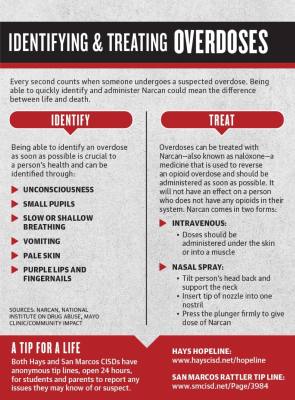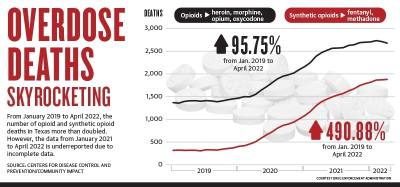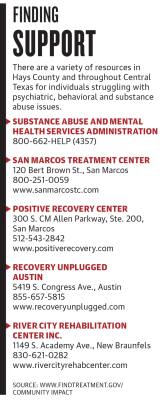“He had such a creative mind; he was fascinating. He wanted to make jet engines, and he was drawing out prototypes on how to do it. He would do the research ... he had these crazy dreams but, to him, it all made sense,” Darren McConville said.
Kevin had been taking what he thought was Xanax or Percocet to help him sleep, according to his mother; however, he unknowingly took a pill laced with fentanyl which is 50 times stronger than heroin and 100 times stronger than morphine, according to the Centers for Disease Control and Prevention.
Fentanyl is the No. 1 leading cause of death in people ages 18-45, and 99% of fentanyl overdoses are an accident, according to the Texas National Guard.
“There was nothing that I would say that stood out to me, thinking back, absolutely nothing. I wish there was [a red flag],” Shannon McConville said. “But I cannot think about that because ... there’s nothing that is going to bring my son back. The only thing we can do is prevent it from happening to some other family.”
Kevin was set to begin his senior year at Lehman High School in August and is one of the four HCISD students to die from a fentanyl overdose, or “poisoning,” since July.
“Unfortunately, most who die from fentanyl didn’t even know that they were taking it. They were poisoned unwittingly by a pill that appeared to be some type of real medication,” Gov. Greg Abbott said at a press conference regarding fentanyl activity Sept. 21.
At the tail end of the 2021-22 school year, HCISD officials began to take notice of the silent killer that had infiltrated its students.
“We had our first incident where we had to use our Narcan toward the end of May. We knew that we had had some suspected cases of fentanyl use,” HCISD Chief Communication Officer Tim Savoy said. “That’s probably about when we first noticed that there might be a problem.”
Narcan, also referred to as naloxone, is a medicine used to reverse an opioid overdose. HCISD now has Narcan available on all campuses across the district, and school resource officers who patrol schools also have it at the ready.
Despite its ability to reverse an overdose, it is not a perfect safety net, according to Kyle Police Chief Jeff Barnett. A dose of Narcan used to be 2 milligrams but has increased to 4 milligrams.
“That is because it was not specifically designed for fentanyl use; it was designed for an opioid overdose,” said Kevin Hager, TNG Drug Demand Reduction Outreach Program manager. “Because fentanyl itself is so potent, they increased the dose of it, but it still requires more than a single dose in most cases.”
The clandestine killer
Fentanyl is a synthetic opioid used for pain management and is prescribed by doctors for severe pain and advanced-stage cancer, according to the CDC. However, the fentanyl that is taking lives across the country is known as illicit fentanyl, created through pill-pressing laboratories.
Fentanyl seeps its way into the country through transnational crime organizations that smuggle across the Canadian and Mexican borders. China is also one of the primary sources of fentanyl and fentanyl-related substances, according to the Drug Enforcement Administration.
Local law enforcement agencies began to take note of the illusive opioid sweeping the nation as it began to claim lives in the area.
“For many years, overdose calls were not typically a police matter. ... But when people started dying more regularly, it certainly became a police matter, and we started devoting resources to it,” Barnett said.
Since late 2021, the Kyle Police Department has responded to at least 25 fentanyl-related overdoses, which included seven deaths. The Hays County Sheriff’s Office has responded to 10 overdose deaths from July 2021-22. Officials estimate the true number could be higher.
“That does not count the calls that the city of Kyle has gone to, the city of Buda, the city of San Marcos,” Hays County Deputy Anthony Hipolito said. “These are just calls that our sheriff’s office has gone to that ended up in death.”
Because the fentanyl-related deaths began slowly in 2021 and ramped up in 2022, local law enforcement agencies did not track them as closely as they are now, Barnett said.
“In the early months, it was still a new phenomenon for our region, so we weren’t necessarily tracking them as part of the bigger picture. They were new to our area and more treated as independent events. There was no trend, really, to see at that point,” Barnett said.
A call to action
The DEA, KPD and HCSO held a joint press conference Sept. 8 as an autopsy yielded a fourth student death due to fentanyl.
Autopsies are ordered by a Hays County justice of the peace, of which there are six, covering different parts of the county.
“Kyle just happens to be the busiest precinct,” Precinct 2 Justice of the Peace Beth Smith said. “I guess it’s because I’m the sole JP here, and in San Marcos there are two covering the same territory.”
At crime scenes, it is up to the JP to determine whether to order an autopsy. However, all autopsies for Hays County are conducted by the Travis County Medical Examiner’s office.Beth Smith said that autopsy results take around 90 days, and she still has outstanding autopsies pending.
To combat the spike in fentanyl activity in the area, the DEA and TNG are partnering with local law enforcement agencies to create a task force to track down and arrest individuals peddling pills containing illicit fentanyl, DEA Assistant Special Agent Tyson Hodges said at the press conference.
“We have joined with federal, state and local law enforcement partners to help us quickly identify related fentanyl deaths and to immediately initiate a criminal investigation and to share resources with all of our partners, and they’re doing the same with us,” Barnett said. “What might take days or weeks in the past now takes minutes to hours.”
Progress has already been made as Barnett announced two arrests at the Sept. 8 press conference. Anthony Jean Perez Rios, a 20-year-old from San Marcos, was arrested and faces charges of alleged manufacture/delivery/possession of a controlled substance, delivery of a controlled substance to a minor and possession of a controlled substance.
A second person arrested is a minor, and their information was not released.The operation will compile data using connecting platforms and software for readily accessible information throughout the region, Barnett said.
In addition to tracking and enforcing fentanyl distribution, there is an educational component as well, under the TNG Joint Counterdrug Task Force DDRO program.
Hager and other officials have underscored the need for parents to be engaged in their children’s lives, especially regarding social media as it is the primary way kids get ahold of drugs.
“They can have anyone deliver whatever they want to them at any time, and that is the true danger right there,” Hager said. “The perception of harm has to be created. This is a deadly, deadly drug.”
A landmine of problems
Another issue alongside the sparsity of tracking the deaths is the preventive measures to keep someone from overdosing.
As education plays a big role in the task force, it is important to recognize the impact that abstinence-based education can have, according to Eli Cortez, organizer and training coordinator for the Texas Harm Reduction Alliance.
The THRA provides outreach for people at risk of opioid overdose in the Austin area. It does this through hygiene kits, safe smoking kits, safe injection kits and fentanyl testing strips.A large part of the education portion of THRA is explaining how to properly use Narcan and encouraging people to test their drugs.
However, fentanyl testing strips that can easily prevent an overdose are illegal and classified as drug paraphernalia in many states across the country—Texas included—Cortez said.
In interviews with overdose survivors, Barnett said that they knowingly ingested fentanyl, though the motives for that remain unclear.
Kenneth Smith, a Texas State University professor in the School of Social Work, said that most people do not actively seek fentanyl, heroin or any other hard drug right off the bat. But, individuals may seek something stronger as their tolerance increases.
In many cases, there is clinically a bigger mental health issue at play as addiction comes in the form of comorbidity: two or more diseases at once, Kenneth Smith said. Tackling this would require greater access to health care and reeling back on the stigma surrounding mental health.
Reframing the deaths
Carilu Bell, of Austin, hopes to raise awareness surrounding fentanyl and the stigma that is attached to the word “overdose,” following the death of her son, Casey Copeland.
A certified personal trainer and Texas State alumnus, Copeland died in August 2021 from taking what he thought was Valium but turned out to be fentanyl.“I thought it had to have been due to natural causes ... it wasn’t until I got the toxicology report back to find out it was fentanyl,” Bell said.
Lawmakers aim to reclassify fentanyl overdoses and poisonings during the upcoming 88th Texas Legislative session that begins in January. If reclassified, individuals who are caught distributing fentanyl to unsuspecting people could be charged with murder.
In July 2021, Gov. Abbott signed Senate Bill 768 which enhanced criminal penalties for manufacturing and distributing fentanyl in Texas.
“Connecting fentanyl to the responsibility of death for another individual—we would just have to coordinate with the district attorney to determine the amount of culpability for that death and determine the most appropriate charge,” Barnett said.
He added that there are a variety of factors that can affect the overall charge including age of the victim, intent, knowledge and more.
Officials say that the most important stronghold in the war against fentanyl is education and outreach. Parents should be engaged with their children and learn about the dangers of the drug claiming the lives of people of all ages.
“Don’t ever think that this could not happen to your child because it can. So many parents, I’m sure, have thought that this would never happen to their child, and it has,” Bell said. “I’m very blessed to have had my child for 44 years. My heart was forever broken; my heart breaks more for these parents that are losing their young teens.”










